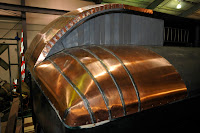A critical responsibility of every museum is the general protection of the Collection. Broadly defined, that could mean protecting it from everything, which is unrealistic. However, prudent steps can be taken to protect the collection from things that could reasonably occur. Examples may include exposure to bright sunlight, rapid changes in heat or humidity, small to moderate earthquakes, and fire.
 |
An articulated lift allows a fire alarm
technician to exchange fire detection
sensors inside the Train Shed, high above
chapel car Messenger of Peace.
|
Inside the Northwest Railway Museum's new Train Shed exhibit building, some of the most important and representative objects in the Collection are protected with UV-filtering windows, R-30 insulation, a structure designed to the most modern seismic code, and a fire detection and suppression system. Yet no system is perfect and unfortunately the Museum has had a variety of issues with the fire detection system.
Local codes required smoke detectors in the original construction because, as Spike has been advised, they often detect a fire sooner than a heat sensor. However, in a building with fans running all the time and nearly 750,000 cubic feet of air, there have been problems with these sensors. Since completion in 2010, the Train Shed has experienced as many as 50 false alarms. Fortunately, the Snoqualmie Fire Department has been very understanding and supportive, and several fire fighters now know almost as much about the Collection as some of the regular docents. However a problem like this cannot be allowed to continue. Aside from the story about T
he Boy Who Cried Wolf, what if the fire department is responding to a false alarm when your house is on fire?
The Museum and its contractor partners have worked hard to determine the cause of the false alarms from the smoke detectors. The Train Shed is not particularly dusty - in fact a lot cleaner than the Conservation and Restoration Center, which also has a number of smoke detectors. There are no sudden changes in temperature that could cause condensation to form inside the detectors. The model of sensor does not have a history of issues. There has even been consideration as to whether an infestation of insects or spiders is causing the problem. However, without being able to pinpoint an exact cause, it has been determined that smoke detectors are not reliable inside the Train Shed, and the local municipality approved a change.
Early in August 2013, E Squared Systems was on site to replace the smoke detectors with heat sensors. This is quite a feat in a structure filled with artifacts, with ceilings as high as 35 feet, and not a lot of floor space to operate a 14,000-pound lift. Now the Museum looks forward to improved reliability, and the Snoqualmie Fire Department looks forward to fewer late night museum visits.





